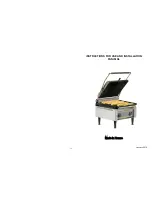
Proper Use Of Tool
Your new Air Hammer is designed for chipping,
riveting and scaling metal and stone. In general
terms, a reciprocating free piston in the cylinder of
the tool imparts a blow to the chisel or working
attachment. Use only approved accessories with the
air hammer.
Do not use the tool for any other purpose than that
specified without consulting the manufacturer or the
manufacturer’s authorized supplier. To do so may
be dangerous.
Work Stations
Your air hammer should only be used as a hand
operated tool. It is always recommended that the
tool is used when standing with solid footing. It can
be used in other positions but before any such use,
the operator must be in a secure position having a
firm grip and footing.
Putting Into Service
Air Supply
Use a clean lubricated air supply that will give a
measured air pressure at the tool of 90 psi/6.2 bar
when the tool is running with the trigger fully
depressed. Use recommended hose size and length.
It is recommended that the tool is connected to the
air supply as shown in figure A. Do not connect the
tool to the air line system without incorporating an
easy to reach and operate air shut off valve. The air
supply should be lubricated. It is strongly
recommended that an air filter, regulator, lubricator
(FRL) is used as shown in figure A as this will
supply clean, lubricated air at the correct pressure
to the tool. Details of such equipment can be
obtained from your supplier. If such equipment is
not used then the tool should be lubricated by
shutting off the air supply to the tool and then
depressurizing the line by pressing the trigger on
the tool. Disconnect the air line and pour into the
intake bushing a teaspoon (5 ml) of a suitable
pneumatic motor lubricating oil, preferably
incorporating a rust inhibitor. Reconnect tool to air
supply and run tool slowly for a few seconds to
allow air to circulate the oil.
Lubricate tool daily if used frequently, or when it
starts to slow or lose power.
Operating Instructions
Select chisel/attachment to perform the work task
and ensure that the chisel retainer is securely fitted.
Do not use tool without retainer spring retainer
securely
fitted. While firmly gripping the tool with
the right hand, grasp the barrel with the left hand.
The tool’s power is controlled by the pressure
exerted on the trigger. Always ensure that the tool is
in contact with the workpiece before pressing the
trigger. Running the tool free will reduce tool life by
placing unnecessarily high loads on the retainer
spring and cylinder.
Using A Percussive Air Hammer
1)
Read all instructions before using this tool. All
operators must be fully trained in its use and
aware of these safety rules.
2)
Do not exceed the maximum working air
pressure of 90 psi/6.2 bar.
3)
Use personal safety equipment.
4)
Use only compressed air at the recommended
conditions.
5)
If the tool appears to malfunction, remove from
use immediately and arrange for service
and repair.
6)
If the tool is used with a balancer or other
support device, ensure that it is fixed securely.
7)
Always keep hands away from the working
attachment fitted to the tool.
8)
The tool is not electrically insulated. Never use
the tool if there is any chance of it coming into
contact with live electricity.
9)
When using the tool, always adopt a firm
footing and/or position and grip the tool firmly
to counteract any forces or reaction forces that
may be generated while using the tool.
10) Use only correct spare parts. Do not improvise
or make temporary repairs.
11) Do not lock, tape, wire, etc. the on/off trigger in
the run position. The trigger must always be
free to return to the “off” position when it
is released.
12) Always shut off the air supply to the tool and
depress the trigger to release air from the feed
hose before fitting, adjusting or removing the
working attachment.
13) Check hoses and fittings regularly for wear.
Replace if necessary. Do not carry the tool by its
hose. Ensure the hand is removed from the
on/off trigger when carrying the tool with the
air supply connected.
14) Take care against entanglement of moving tool
parts with clothing, ties, hair, cleaning rags, etc.
This will cause the body to be drawn towards
the tool and can be very dangerous.
Specifications
Especificaciones
Fiche technique
US
F
E
Average Air
Consumption
2.1 CFM (15 SCFM)
100% Usage
Promedio de
consumo de aire
2.1 CFM (15 SCFM)
Uso al 100%
Consommation
moyenne d’air
2,1 pi
3
/min (15 SCFM)
Usage à 100 %
Blows Per Minute
3,500
Golpes por minuto
3.500
Coups par minute
3 500
Chisel Shank Size
0.401"
Tamaño del vástago
del cincel
0.401 pul.
Taille de la queue
du ciseau
1 cm (0,401 po)
Air Inlet
1/4" NPT (F)
Entrada de aire
Rosca de 1/4 pul.
NPT (Hembra)
Entrée d’air
Taraudage de
6,35 mm NPT (F)
Weight
3.2 lbs.
Peso
3,2 lbs.
Poids
3,2 lb
Min. Hose Size
3/8"
Tamaño mínimo de
la manguera
3/8 pul.
Taille minimale du
tuyau
9,5 mm (3/8 po)
Required PSI
90
Lbs./pul
2
(PSI)
necesarias
90
Pression requise en
lb/po
2
90

























